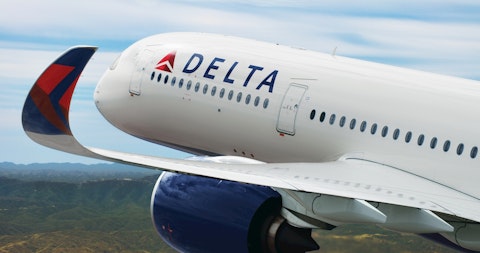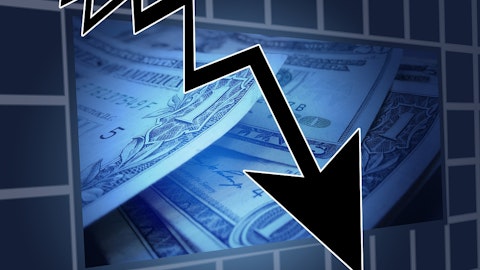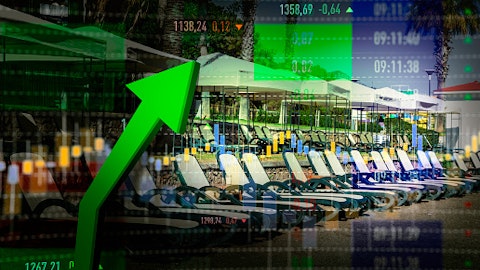Delta Air Lines, Inc. (NYSE:DAL) Q2 2023 Earnings Call Transcript July 13, 2023
Delta Air Lines, Inc. beats earnings expectations. Reported EPS is $2.68, expectations were $2.4.
Operator: Good morning, everyone, and welcome to the Delta Air Lines June Quarter 2023 Financial Results Conference Call. My name is Matthew, and I’ll be your coordinator. At this time, all participants are in a listen-only mode, until we conduct a question-and-answer session following the presentation. As a reminder, today’s call is being recorded. [Operator Instructions] I would now like to turn the conference over to Julie Stewart, Vice President of Investor Relations. Please go ahead.
Julie Stewart: Thank you, Matthew. Good morning, everyone, and thanks for joining us for our June quarter 2023 earnings call. Joining us from Atlanta today are CEO, Ed Bastian; our President, Glen Hauenstein; our CFO, Dan Janki. Ed will open the call with an overview of Delta’s performance and strategy. Glen will provide an update on the revenue environment, and Dan will discuss costs and our balance sheet. After the prepared remarks, we’ll take analyst questions. We please ask that you limit yourself to one question and a brief follow-up, so we can get to as many of you as possible. And after the analyst Q&A, we will move to our media questions. Today’s discussion contains forward-looking statements that represent our beliefs or expectations about future events.
All forward-looking statements involve risks and uncertainties that could cause the actual results to differ materially from the forward-looking statements. Some of the factors that may cause such differences are described in Delta’s SEC filings. We’ll also discuss non-GAAP financial measures, and all results exclude special items unless otherwise noted. You can find a reconciliation of our non-GAAP measures on the Investor Relations page at ir.delta.com. And with that, I’ll turn the call over to Ed.
Ed Bastian : Thanks, Julie. Good morning, everyone. We appreciate you joining us. Today, thanks to the great work of our team, we announced record revenue and earnings, reflecting the strength of demand for and momentum of Delta’s differentiated brand. During the June quarter, we generated earnings of $2.68 per share, a 90% increase over last year. This marks the highest quarterly earnings result in our history, an achievement that moves Delta beyond recovery and firmly on a great path forward. Revenue was 19% above last year, and we achieved a 17% operating margin. This resulted in operating income of $2.5 billion bringing our operating profit over the last 12 months to $6 billion. We generated over $1 billion of free cash during the quarter, bringing our first half free cash flow to $3 billion.
We continue to repay debt and we’ve reinstated the quarterly dividend, signifying strong execution on our three-year plan and creating value for our owners. At Delta, transportation is what we do, but experiences are what we deliver, and that’s made possible by the exceptional service provided by the industry’s best employees. The 90,000 Delta people continue to deliver for our customers during this busy summer season. Over the 4th of July weekend, our people delivered a great operation, completing over 21,000 flights with a 99.5% completion factor and industry-leading on-time performance. The Delta people continue to be recognized. During the quarter, The Points Guy ranked Delta as the best U.S. airline for the fifth year in a row with consistently high scores for reliability, customer experience, network and loyalty.
Sharing our success with our team is core to Delta’s culture, and we continue to maintain a position of industry leadership on pay. During the quarter, eligible employees received a 5% pay increase on the 1st of April. And year-to-date, we have accrued over $660 million in profit sharing, in fact more than the total profit sharing paid out for full year 2022. We expect our profit sharing payout next February will continue to lead the industry by a wide margin. We will always be guided by our values of putting our people and our customers first. They are the driving force of our success. I want to thank our entire team for all they do for Delta and our customers. As I’ve recently noted, the industry backdrop remains constructive. Air travel demand is strong and the consumer is in good financial shape, particularly the premium consumer base that we target.
After years of spending on goods, consumers want to travel. It’s their #1 big-ticket purchase priority and they desire premium experiences. No one provides this better than Delta. At the same time, aviation infrastructure is still fragile, and the industry continues to face multiple constraints across the supply chain, aircraft delivery delays and training needs. As a result, we see a significant gap between the supply that is in place and what demand could sustain. And we expect this gap will remain for an extended period of time. Turning to our outlook. With our first half performance and visibility into the back half of the year, we are raising our full year outlook and now expect earnings of $6 to $7 per share. For the September quarter, demand momentum continues.
We expect to deliver double-digit revenue growth of mid-teens operating margin and earnings of $2.20 to $2.50 per share. Glen and Dan will provide more details on the components of our outlook. As we move to 2024 and beyond, our path forward is clear. The strategy that we shared at our Investor Day just a few weeks ago positions Delta incredibly well for the future. Our long-term priorities are to run the world’s best airline, unlock the power of our brand, transform through digital and deliver long-term shareholder value. Our strategy is underpinned by a commitment to financial performance, with a focus on free cash flow, return on invested capital and earnings durability. We are currently executing ahead of our three-year financial plan and are well positioned to achieve our 2024 earnings target of over $7 per share.
On free cash flow, we introduced a new goal to generate over $10 billion of free cash flow from 2023 to 2025. The strong cash generation will enable us to return our balance sheet to investment-grade metrics, while consistently reinvesting in the business. In closing, thanks to the outstanding work of our people, Delta continues to set itself apart. We have unique opportunities to grow earnings by leveraging our powerful brand, extending our durable competitive advantages and accelerating our digital transformation. One other point I’d like to add. While our team has been hard at work returning the level of excellence to the skies that our customers deserve, we have not let go of our commitments to our community. Our team was recently recognized as the #1 corporate blood drive donor with the American Red Cross for the sixth consecutive year with the record units of blood collected.
To me, these types of achievements are as rewarding as the great financial and operational results that we are publishing today and what makes this company truly great. Thank you again. And with that, let me turn the call over to Glen and Dan to go through the details of the quarter.
Glen Hauenstein : Thank you, Ed, and good morning. I want to start by recognizing our people for their exceptional work during the always challenging peak summer travel period. Thank you. Delta produced record June quarter revenue of $14.6 billion, up 19% over last year. Revenues were ahead of our initial expectations with momentum in June. June 30 was a new record for industry volume and our highest summer revenue day in history. Total unit revenues were up 1.3% over prior year on improved yield and load factor. Consumer demand strength continues to be the primary driver of our revenue growth. Business travel in the quarter improved year-over-year, primarily driven by international. Overall, international passenger revenue grew 61%, led by the TransAtlantic and Latin America.
Domestic passenger revenue was 8% higher on a similar capacity increase. Premium revenue grew 25%, supporting growth in unit revenues and continuing to outperform main cabin. Delta Premium Select is now offered on over 80% of our wide-body fleet and customer response to the product has been terrific with returns outpacing our expectations. Total loyalty revenue was up 20% versus last year, with continued momentum in our American Express co-brand portfolio. Remuneration of $1.7 billion was 22% higher year-over-year with $3.4 billion through the first half. We are firmly on track to exceed the $6.5 billion target for this year and focused on reaching our new long-term goal of $10 billion. Turning to the outlook. For September quarter, we expect total revenue to be similar to 2Q, increasing 11% to 14% year-over-year.
On capacity outlook of 16% growth, unit revenues are expected to be 2% to 4% lower. While a deceleration from the June quarter, this is consistent with historic performance between 2Q and 3Q when factoring in the holiday shifts and tougher international comps as we lap the removal of restrictions. Domestically, demand remains robust, and our core hub rebuild is advancing with growth focused in Atlanta. In our coastal hubs, we are leveraging facility investments and progressively improving margins. On international, demand strength is continuing, and we are confident in delivering record profitability and margins across all three international entities. System bookings for travel beyond Labor Day are encouraging into the fall. On corporate, we expect steady improvement in demand.
Our recent corporate survey shows businesses expect to increase travel in the second half with several of the least recovered sectors conveying optimism or increased travel in the fall. Similar optimism was reflected in Morgan Stanley’s recent global corporate travel survey, where respondents indicated travel was expected to grow 9% year-over-year in the second half and 8% into 2024. Delta’s capacity growth will normalize to mid-single digits in 2024, enabling us to further improve reliability, optimize the network and drive efficiency to reduce unit costs and support margin expansion. With an integrated and proven commercial strategy and the best people in the industry, we have significant opportunity ahead. In closing, I’m so proud of the team for delivering a great first half of the year and excited about the momentum we are building.
Dan Janki : Great. Thank you, Glen, and good morning to everyone. In the June quarter, we delivered earnings of $2.68 per share and operating margin of 17%, ahead of our guidance and a significant improvement over last year. Our nonfuel unit costs were down — were up 2.4% year-over-year. Fuel prices for the quarter averaged $2.52 per gallon, including a refinery benefit of $0.04. We generated operating cash flow of $2.6 billion. And after reinvesting $1.6 billion into the business, free cash flow was $1.1 billion. Liquidity ended the quarter at $8.8 billion, with adjusted net debt of $19.8 billion. During the first half of 2023, we repaid $3 billion of debt, including $1.4 billion of early repayments with a focus on our high-cost debt.
For the year, we expect to repay over $4 billion of gross debt resulting in interest costs over $100 million lower than our initial expectations. Our leverage ratio improved to 3.2x on a trailing 12-month basis and this is down from 5x at the end of the year. During the quarter, we announced the reinstatement of a quarterly dividend, opening the shareholder base to yield focused investors. Now moving on to guidance for the September quarter and full year. We expect mid-teen operating margins and earnings of $2.20 to $2.50 per share in the September quarter. Nonfuel unit costs have reached an important inflection point. We expect nonfuel unit costs to decline 1% to 3% year-over-year in the September quarter. This is consistent with our expectations for a low single-digit decline in the second half of 2023.
Rebuild costs are substantially behind us and capacity is returning through our most efficient core hubs. July marks our peak ASM production for the year and capacity seasonally declining in the fall and winter. As our capacity growth normalizes, it enables our operating teams to drive efficiency. We have over $1 billion opportunity from initiatives across the enterprise as hiring and training slow and our workforce gains experience. Improving our nonfuel unit cost is an enterprise-wide priority, and remains within our control. On fuel, we expect the September quarter fuel price to be between $2.50 to $2.70 per gallon. This includes a $0.04 refinery benefit. As part of our routine maintenance done once every five years, the refinery will undergo a turnaround in mid-September that will continue through November.
With production offline during this period, we expect the refinery to breakeven during the second half of the year. With our second quarter performance and our third quarter outlook, we now the full year earnings to be $6 to $7 per share and an operating margin greater than 12% and free cash flow of $3 billion. Delivering these financial results also positions us to reduce our leverage ratio to 3x by the end of the year and significantly improve our return on invested capital. For the full year, we expect our return on invested capital to be approximately 14%, a 6-point improvement versus last year. In closing, we’re ahead of plan in 2023. And in 2024, we remain confident in delivering earnings per share of over $7 a share while generating over $4 billion of free cash flow and achieving our investment-grade metrics.
As we shared at Investor Day, we see significant opportunities beyond 2024 as we build on the strength of the core airline, leverage our existing capital base to grow high-margin revenue streams and delivered durable earnings through a full economic cycle. We couldn’t do this without the hard work of our employees who are delivering for our customers every day. I’d like to thank the Delta people for all they do. Now with that, I’d like to turn it back to Julie for Q&A.
Julie Stewart : Matthew, can you please remind the analysts how to queue up for questions?
See also 15 Franchises That Run Themselves and 15 Free International Dating Sites Without Payment.
Q&A Session
Follow Delta Air Lines Inc. (NYSE:DAL)
Follow Delta Air Lines Inc. (NYSE:DAL)
Operator: [Operator Instructions] Your first question is coming from Helane Becker from TD Cowen.
Helane Becker : I just have a point of clarification and then my question. The point of clarification is, Dan, did you just say that you’re going to do more than $4 billion in free cash flow for this year, and is that an official guidance update? And then my question really has to do with as you think about your digital footprint and the technology investments that you have to make, how are you thinking about what’s customer facing versus what’s back office and the cost to invest in both?
Dan Janki : I’ll start with the first one. And as it relates to free cash flow for this year, 2023, at Investor Day, we raised our guidance from $2 billion to $3 billion. $3 billion is the number for this year. And we expect as part of our three-year plan, we said that we’d be at $4 billion or greater in 2024. And Ed talked about the three-year collective plan that we’re working towards, which is over $10 billion for the cumulative period of ’23 through ’25.
Ed Bastian : And Helane, on your question regarding digital, I think I mentioned a couple of weeks ago at our Investor Day, I consider this one of the most important activities and investments that we are making in the company. We are — on the one hand, we’re far along. We’ve been working on this for a while, but clearly, we have a lot to go as well. And most of the work that we are doing is clearly within the run rate or CapEx run rate. I don’t anticipate any increase in capital as a result of that. If anything, a lot of the work that should start sunsetting by the end of ’24 in terms of moving our infrastructure to the cloud will start to dissipate and that’ll create even more capacity within the existing spend level for digital.
Operator: Your next question is coming from Ravi Shanker from Stanley.
Ravi Shanker : Glen, you commented on the fall. Any chance you can expand on those comments a little bit more, especially U.S. domestic? I think you spoke about corporate a little bit. I think most folks are focused on what the demand looks like beyond the summer, which is obviously very, very strong right now?
Glen Hauenstein : Right. We see strong demand both domestically and internationally as far as we can see. And we can see internationally, probably to the end of summer, IATA in October and see very, very strong results there. And domestically, we’ve seen some very positive trends. I think that was one of our increases in the June quarter, we’ve talked about in the earnings, and we’ve seen some inflection in terms of closing build, where it’s starting to look better as we move later in the summer, and we’re very encouraged with those trends as well.
Ravi Shanker : Great. And as a follow-up, maybe to Ed or Dan, kind of you’re going to hit your long-term EPS target of $7 at the high end of your guide this year, which obviously is very, very impressive. But I think what’s the next bar here, what’s the next step? Are you looking at $10? And obviously, just give us kind of the long-term outlook and the beyond Analyst Day in terms of the initiatives out there. But what are we thinking in terms of kind of financial targets for the long term?
Ed Bastian : Hi, Ravi. We’re going to — we need to get to $7 first before we talk about what’s next. And…
Glen Hauenstein : We’re only halfway through a three year plan.






